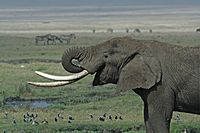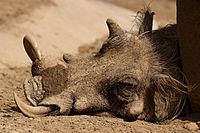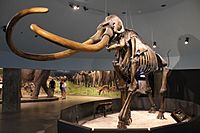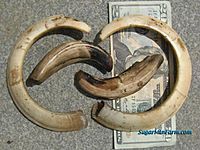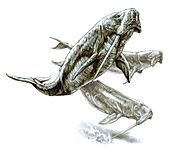Tusk facts for kids
Tusks are long, special teeth that stick out from the mouths of certain mammals. They keep growing throughout an animal's life. For animals like pigs and walruses, tusks are actually their long canine teeth. But for elephants, tusks are very long incisors (front teeth).
Tusks usually grow in pairs, one on each side of the mouth. They are often curved and have a smooth surface. However, the narwhal is different! It usually has just one straight, spiral tusk that grows from the left side of its mouth. This tusk is mostly found on male narwhals.
Tusks can grow very large. In the past, elephant tusks weighing over 90 kilograms (200 pounds) were common. But because of hunting, it's rare to see tusks over 45 kilograms (100 pounds) today.
Besides mammals, an ancient group of animals called dicynodonts are the only other known creatures to have had true tusks.
How Animals Use Their Tusks
Animals use their tusks for many different things. The way they use them depends on the animal.
- Showing Off: Some animals, especially males, use their tusks to show who is stronger or more important in their group.
- Defense: Tusks are great for protecting themselves from other animals that might attack them.
- Tools: Elephants use their tusks like tools. They can dig for water or roots and even lift things with them.
- Moving Around: Walruses use their tusks to grip onto ice and pull themselves out of the water. They can also use them to move across icy land.
Scientists believe that tusks have changed over time to help animals live in different places, like dry lands, water, or very cold areas.
Tusks and People
Humans have used tusks for a long time to make a material called ivory. Ivory is beautiful and has been used to create art, jewellery, and even parts of musical instruments like piano keys.
However, because ivory was so popular, many tusked animals were hunted a lot. This hunting has caused several tusk-bearing species to become endangered, meaning they are at risk of disappearing forever. To help protect these animals, the United Nations has an agreement called CITES (Convention on International Trade in Endangered Species of Wild Fauna and Flora). This agreement strictly controls the trade of ivory and other animal products.
Sometimes, animals in zoos or wildlife parks might have their tusks trimmed or even removed by vets. This is done for their health and safety, or to prevent them from accidentally hurting other animals or people.
Gallery
-
Tusks of a Wild boar
See also
 In Spanish: Colmillo para niños
In Spanish: Colmillo para niños
- Fang, a long canine tooth (in mammals)
- Ivory trade
- Eco-economic decoupling



